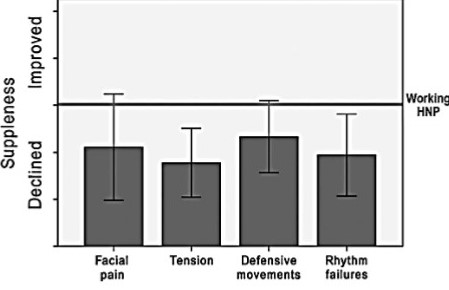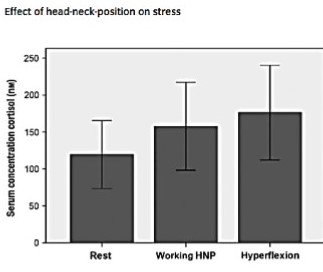Equinamity-A Revolution in Horse and Rider Training

The most immediate and most obvious effect is choking. The horse is being forced to work which demands a rapidly expanding supply of oxygen. However, given its constricted its head and neck position the size of its windpipe is reduced. In many case by as much as half, which blocks the entry of oxygen.
This is not the only difficulty. The following quote indicates some of the other affected areas.
“Hyperflexion involves riding or longeing a horse with his neck and poll tightly flexed and the profile of his face behind the vertical. His head may almost touch his chest or his knees or may be turned to one side or the other. Proponents say the technique improves a horse’s ability to lift and round his topline (essential for collected work) while it supples his muscles and encourages more expressive gaits. Critics say it harms the horse.
There’s unfortunately no consensus in practice on what degree of pressure is considered acceptable or when a pressure becomes force,” Dr. Koenig von Borstel explains. “From a scientific point of view, a good threshold would be the amount of pressure a horse voluntarily accepts, for example, in an attempt to reach a food reward. These values are very commonly exceeded during regular riding and more so when riding horses in strongly flexed postures.”
Negative effects appeared regardless of how flexion was achieved, how long the horse maintained it or whether the horse had been previously trained in hyperflexion. They included:
After its 2015 conference, ISES/International Society for Equitation Science issued a position statement. It said, in part: “Riders, trainers and sports officials must be aware of the gradual effect of flexion on welfare. They must ensure that head and neck postures do not compromise physiological or psychological function. Maintaining an open airway and ensuring the horse is self maintaining the posture are essential. (rather than it being enforced by the rider/trainer and/or tack or equipment)”.
The following quote is taken from a video published by Horse Source in 2017 which summarizes a full range of possible negative consequences.
“Rollkur, over-bending, absolute elevation, and over-flexion is not beneficial to a horse physically or mentally. It is only beneficial for the human to skip steps in training and win in the show ring. These headsets can cause acute pain, chronic pain, inflammation, breathing issues, vision limitations, nerve pain, back and neck pain, jaw and bar pain. They can also cause breaking at the third and fourth vertebrae, teeth and skull damage, muscles soreness, and asphyxia among other things.
Overtime, permanent damage can occur to trachea and spine. Rollkur puts the horse on the forehand and out of balance; the horse then compensates with other muscles and this results in fake collection and a hollow back. These head positions create an unhappy, frustrated horse that quickly becomes mentally shut down due to pain and little release. Horses are pulled, kicked and abused until they carry their head in the desired position; the horse then keeps it there to avoid pain, not because it is natural or comfortable. Tail swishing, “dead eye”, open mouths, and backward ears are not signs of a comfortable horse”.
There are many ways and it shows up both physically and mentally. The 10 most commonly observed behaviors of the Ridden Horse Pain Ethogram are listed next.

The above list shows the behavioural actions undertaken by the horse to alleviate the stress that it is under. Neither are they remote. The statistics show that a large number of competitors at high level are involved.
Another study obtained evidence on the effect these actions have on the overall level of performance of the horse. These are shown next. They are taken from the following article.
Several of the key physical manifestations are shown in the next table.


One of the ways in which horses reveal their internal stress is via the secretion of cortisol which is also known as the “stress hormone”.
The following chart shows the increased amount of cortisol generated by hyperflexion-rollkur when compared with a working HNP and rest.

The authors state: “The evaluation of rider and observer resulted in clear changes of rideability and behavioural changes for the worse, This occurred in all parameters collected between a working HNP and hyperflexion. In conclusion, changes of the cortisol blood level as a physical parameter led to the assumption that hyperflexion of head, neck and poll effects a stress reaction in the horse. And observation of the behaviour illustrates adverse effects on the well-being of horses during hyperflexion.”
Especially as a result of the disharmony created by hyperflexion-rollkur much of it via the ethogram. This has been done by a substantial number of academics across numerous countries from respected institutions as well as private organizations. This research has been conducted using correct and verifiable scientific methods and conditions.
However, other equine academics from a leading European University conducted a study in 2012 on this issue. By way of context by this time over 100 studies had already been conducted on the subject of stress in horses. The overall tendency pointed overwhelmingly to its negative effects.
In spite of this, their conclusion was that: ““definite scientific evidence for the indicative value of most of these behaviours is lacking”. The author is sure that most/all of those researchers involved in identifying stress in horses would regard this claim is both misleading and irresponsible, as well as being a violation of academic integrity. Which is the search for truth.
In addition, a creates a strong suspicion that these researchers, all of them with advanced veterinary degrees, were approaching this subject with several seriously biased views.
It is essential for both horse welfare and for scientific truth that the factors identified above be explained in objective detail. Many excellent studies have already been conducted and Equinamity will include additional high-quality quotes on this subject in subsequent posts.